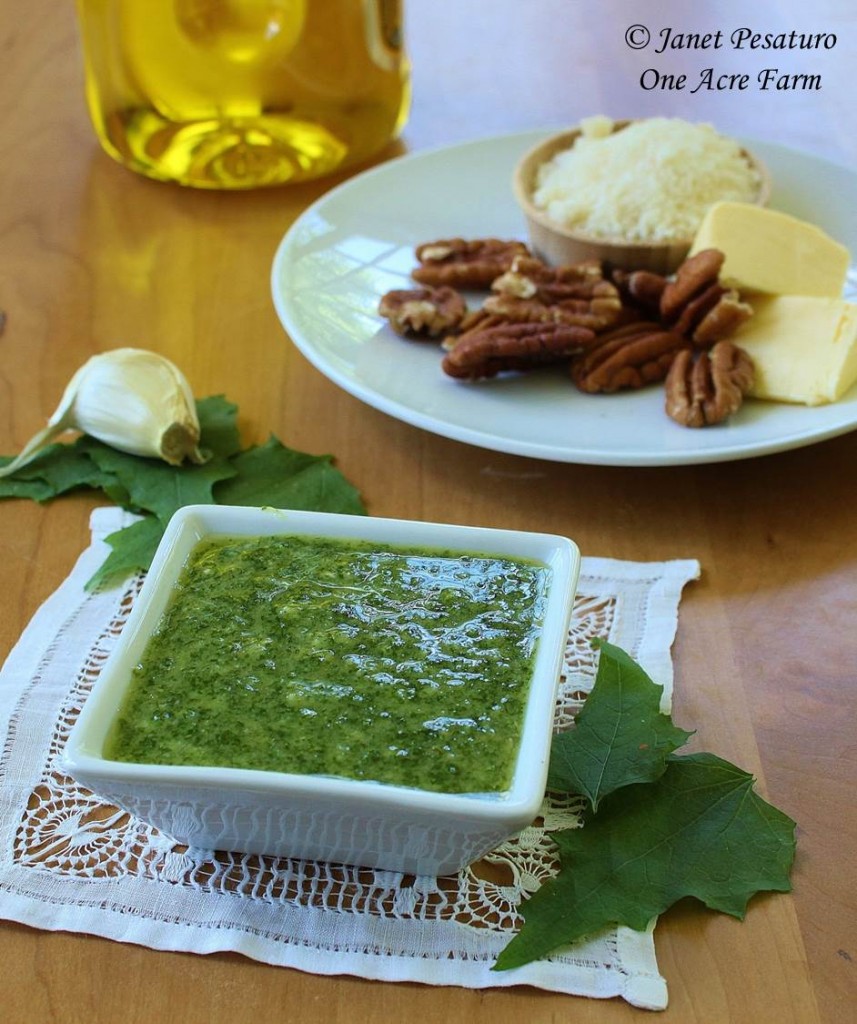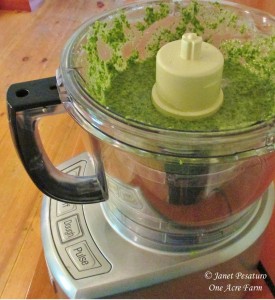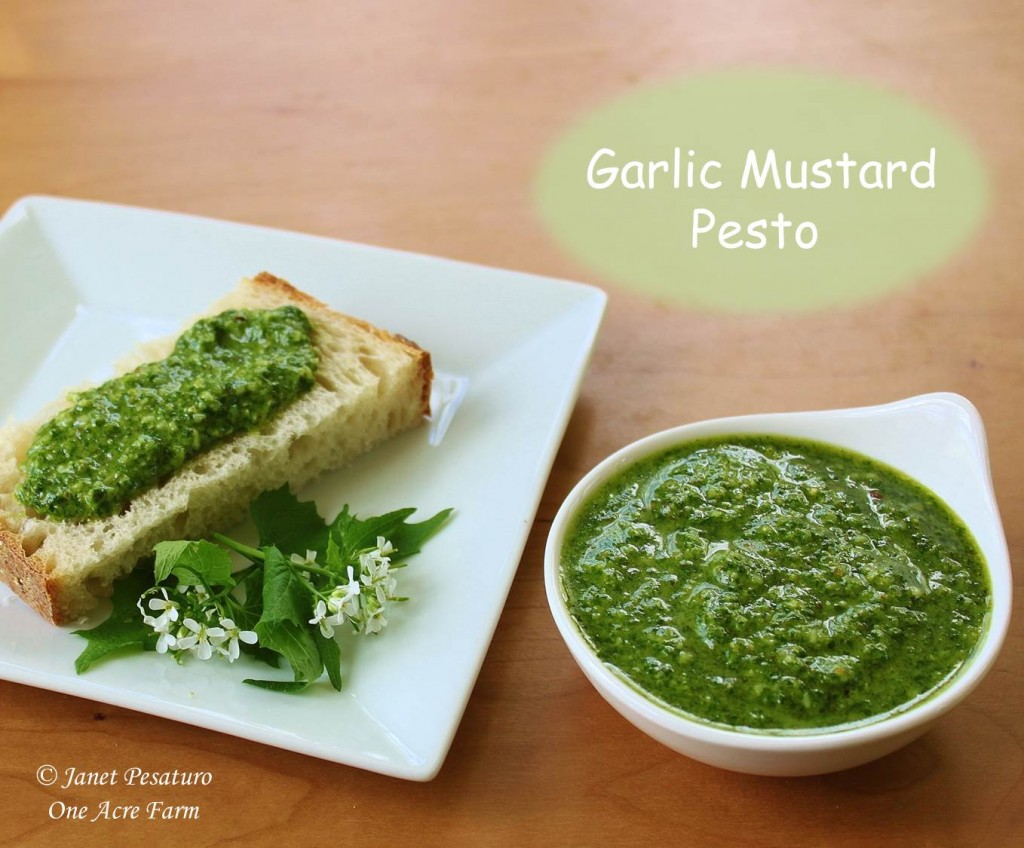The pungent leaves of wild garlic mustard are quite tasty if harvested before the flowers begin to go to seed pods. I had read they make a good pesto, but I was unsure if the flavor would appeal to my family. So, I decided to dilute the mustard with mild flavored baby spinach, which was abundant in the garden at the time. And guess what? We all liked it! So next spring, I hope you forage for garlic mustard yourself, and try this garlic mustard pesto with baby spinach.
The recipe below is exactly how I made it. To balance the strong flavor of garlic mustard, I chose a mild cheese and a mild nut. I also used less garlic than I use for basil pesto. But garlic mustard isn’t as strongly flavored as I expected, and this pesto is rather mild, so next time I will make it a little stronger. I’ll probably try one or more of the following:
- More garlic mustard and less spinach
- An additional clove of garlic
- A stronger cheese, such as Romano, which I usually use for basil pesto.
So feel free to customize this to your own taste buds!
You will need a blender or food processor. We love our: Cuisinart FP-14DC Elite Collection 14-Cup Food Processor, Die Cast
Garlic mustard pesto with baby spinach
Makes a little more than 1 cup, enough for 1 pound of pasta
- 1 cup loosely packed leaves of garlic mustard, harvested before flowers begin to form pods
- 1 cup loosely packed baby spinach
- 1/4 cup pecans (or pine nuts or other nuts of your choice)
- 1/3 cup grated Parmesan cheese
- 1 clove garlic, peeled
- 1/2 tsp salt
- 1 tbsp butter
- 1/2 cup olive oil
Place all ingredients in a food processor or blender and process until smooth, pushing down the leaves as necessary. (We used it immediately, but I suspect you could refrigerate for up to a week, or freeze.)
Shared on: HomeAcre Hop #77, From the Farm, Natural Living Monday, Homestead Barn Hop #166, Mostly Homemade Mondays #87, Tuesdays with a Twist, Backyard Farming Connection #88, Motivation Monday #99














Pingback: Foraging Garlic Mustard, an Edible Invasive Plant - One Acre Farm
This sounds delicious! We don’t have garlic mustard but we do have tumbleweed mustard in our pasture that I’m planning to harvest for salad greens. I’m curious how they would taste in a pesto so I may try this with ours!
That sounds great, Annie! Learning about edible plants has been a fascinating journey, I must say. So much perfectly good food that we’re all in the habit of pulling up, while we toil over our garden plants. I hope you’ll post about your tumbleweed pesto, as I would love to hear how it turns out!
This looks absolutely delicious. Thank you for not only showing us how to identify and forage for these items but also how to put them to practical use.
Thanks for stopping by, TAH!
I have never made my own pesto. I would have to use pine nuts as we have nut allergies in my home, but what a great way to be fresh! Great summer recipe!
Thanks, Elizabeth! If you like pesto, you should really try making your own. It is wonderful when freshly made. You can even omit the nuts entirely. The greens/herbs you use, plus the cheese, make it very flavorful.
Thanks for sharing this post at The Green Thumb Thursday Garden Blog Hop. We hope you will join us again this week.
This pesto recipe looks delicious and I love how you have used spinach.
Thanks,Tanya.
Thanks for sharing! This was chosen as a favorite on our From the Farm blog hop!
How cool, Dawn, I am honored!!
Janet I am late on this but as Dawn said I chose your pesto post as my fave this week! I love pesto and your photograph was just beautiful! Thank you so much for linking up and I hope you grab the From The Farm Favorite badge for this post! 🙂 Thanks for sharing your from the garden cooking knowledge with all of us!
Thanks, Karen!!
I’ve seen from other sources that garlic mustard contains trace amounts of cyanide and although still edible one should be aware of this an consume with caution. What is your take on this?
Hi Julie. Yes, garlic mustard contains cyanide at about 100ppm, which is 100 mg per kg. Depending on your size, you might get sick from eating 100 mg of cyanide, but that would mean eating a whole kg (about 2.2 lbs) of garlic mustard. Thanks for asking about it, because it’s good to know, but I think it’s safe to say that one can add garlic mustard to salads, sandwiches, and pesto, without coming anywhere near a toxic dose of cyanide.
Pingback: Garlic Mustard Recipes – hedgecraft
Pingback: Spring Foraging ~ 20+ Wild Spring Edibles — Practical Self Reliance
Hi Janet, I was walking today and looked down and saw garlic mustard in bloom. I had seen it before somewhere and I knew it was a wild herb that was edible, but didn’t know what herb it was I was looking at and I searched online for white flowering wild herbs and there was your great photo and I had an aha or deja vu moment! Sometimes photos of plants online can be not precise enough, but your photo is great. I am going to attempt the pesto recipe you have up.
Great! I’ll soon be making some more myself.